 |
 |
 |
 |
 |
 |
| |
 |
|
 |
 |
 |
  |
  |
 |
 |
 |
 |
|
|
 |
|
 |
 |
 |
BUILDING |
 |
|
 |
|
 |
 |
 |
| |
 |
| 
 |
Nanshan Cultural Center
|
|
 |
 |
 |
 |
DESIGNER |
 |
|
|
 |
|
 |
 |
 |
| |
 |
|
 |
 |
 |
 |
DESCRIPTION |
 |
|
|
 |
|
 |
 |
 |
| . |
 |
|
 |
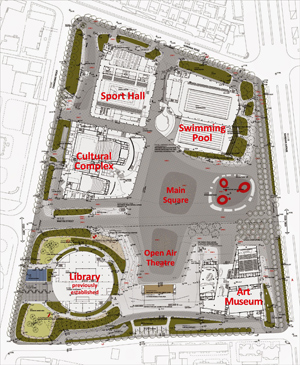 A new performing arts facility inaugurated recently in Shenzhen, China, designed by architects Gabor Zoboki and Nora Demeter of ZOBOKI-DEMETER Architects has joined the ranks of the most unique cultural venues in China. The building houses a multi-functional concert hall holding 1400 seats, a children's theatre of 350 seats, extensive public spaces, all embodied in a large complex of cultural and sports facilities in the heart of Nanshan District. The project is the result of a design process of several years, during which time the architects paid special attention to the local needs as defined by the Client, the Mayor of the District who wished to ensure that the building was planned and built from the perspective of the local community. Despite the general practice in large Asian metropolises, the concert hall works without amplification, promising to offer a new concert venue with world-class acoustics within its wooden-clad hall. Adjacent to the large concert hall a smaller theatre has been created, envisaged as a venue for smaller productions, most notably offering a facility for children, one of the most significant members of the growing cultural communities emerging in China. The complex is linked to a larger sports facility, hosting an array of athletic and sports facilities for the residents and students of Nanshan. A new performing arts facility inaugurated recently in Shenzhen, China, designed by architects Gabor Zoboki and Nora Demeter of ZOBOKI-DEMETER Architects has joined the ranks of the most unique cultural venues in China. The building houses a multi-functional concert hall holding 1400 seats, a children's theatre of 350 seats, extensive public spaces, all embodied in a large complex of cultural and sports facilities in the heart of Nanshan District. The project is the result of a design process of several years, during which time the architects paid special attention to the local needs as defined by the Client, the Mayor of the District who wished to ensure that the building was planned and built from the perspective of the local community. Despite the general practice in large Asian metropolises, the concert hall works without amplification, promising to offer a new concert venue with world-class acoustics within its wooden-clad hall. Adjacent to the large concert hall a smaller theatre has been created, envisaged as a venue for smaller productions, most notably offering a facility for children, one of the most significant members of the growing cultural communities emerging in China. The complex is linked to a larger sports facility, hosting an array of athletic and sports facilities for the residents and students of Nanshan.
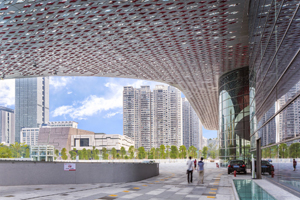 Shenzhen, situated on the border of Mainland China and Hong Kong, was a quiet town inhabited by fishermen and a modest population of 20,000 inhabitants four decades ago. Today it is a huge metropolis with over 15 million residents. Cities of this size tend to lose their human scale, becoming chaotic and spiritless, thus being difficult to live in. In the dynamic development of such cities as Shenzhen, the advances often ignored the cultural needs of the population within an emerging economic environment. It is especially true in cases like Shenzhen, where the cultural development didn’t follow the rhythm of economic growth. In Shenzhen, the places for communal or cultural exchange were limited to karaoke bars and shopping malls leaving a void in the domain of more sophisticated cultural venues. Shenzhen, situated on the border of Mainland China and Hong Kong, was a quiet town inhabited by fishermen and a modest population of 20,000 inhabitants four decades ago. Today it is a huge metropolis with over 15 million residents. Cities of this size tend to lose their human scale, becoming chaotic and spiritless, thus being difficult to live in. In the dynamic development of such cities as Shenzhen, the advances often ignored the cultural needs of the population within an emerging economic environment. It is especially true in cases like Shenzhen, where the cultural development didn’t follow the rhythm of economic growth. In Shenzhen, the places for communal or cultural exchange were limited to karaoke bars and shopping malls leaving a void in the domain of more sophisticated cultural venues.
The leader of Nanshan District at the time, Mayor Liu and several officials of Shenzhen visited Budapest in 2007 and they were impressed by the architectural and technological standards of the Palace of Arts, thereafter inviting Gábor Zoboki to Shenzhen to review the opportunity to act as an interior design consultant for the developing project of the Nanshan Cultural Centre in Shenzhen. The discussions in Shenzhen led to a more complex commission, allowing the two founders of Zoboki-Demeter and Associates - architect and classical musician Gabor Zoboki, and the Yale and U.C. Berkeley graduate architect Nora Demeter - to become involved in the entire planning process and to act as the general designers of the overall project. The scope of the project soon came to include the design of the performing arts facility, a museum for art and the main square housing the overall complex of buildings.
Shenzhen, the New York City of China hosts the buildings of some of the leading architects from the Western world. The headquarters of the Chinese Stock Exchange by OMA, Rem Koolhaas, Ellen van Loon, the new airport by Massimiliano Fuksas, a beautiful office complex by Steven Holl is at the seaside, and the Opera House by Zaha Hadid in the neighbouring Guangzhou are just some of the most recent landmarks. Although the competition to enter this market is intense, the Hungarian architects were able to win the respect of their Client with a key attitude: they were very respectful and passionate about the project.
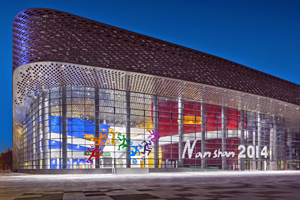 “Everybody wants to enter the markets of the Arab countries and China, but we weren’t thinking about it as selling a product, and two hours later waving goodbye from the airplane. We usually had 10 hours long daily shifts during our weeks in China, returning frequently and working closely on the plans with our partners, three local architect offices." - says Gabor Zoboki about the working process. “Everybody wants to enter the markets of the Arab countries and China, but we weren’t thinking about it as selling a product, and two hours later waving goodbye from the airplane. We usually had 10 hours long daily shifts during our weeks in China, returning frequently and working closely on the plans with our partners, three local architect offices." - says Gabor Zoboki about the working process.
The complex designed by ZDA is placed on the main square in Nanshan district, and besides the performing arts facility and children’s theatre, ZDA designed the interior and facade of the museum as well as participated in the creation of the swimming pool and sports arena. An open-air theatre and a library complete the ensemble of buildings on the square.
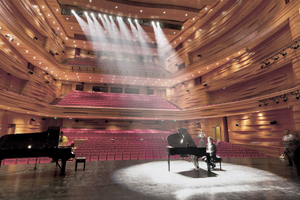 The biggest quest for the architects was to create a public space in an industrial city of 15 million inhabitants. A space which is humane, within which both the visitors and the artists feel at home inside. To achieve this, it was crucial to create a special musical experience through an intimate atmosphere and state-of-the-art acoustic environment. The architects’ first step was to convince city officials that instead of a 3000 capacity concert hall, 1400 seats are adequate. In China, the use of amplifiers is quite usual, but as in the Palace of Arts in Budapest, within the Nanshan Cultural Centre there is no need for electronic amplification, the result of the collaboration between the architects and acoustic expert Federico Cruz Barney. The hall’s acoustic volume is appropriate for both a grandiose Beethoven symphony and a Chopin sonata, each having the best sounding environment. Another architectural and acoustic achievement of the creators is the development of an adjustable ceiling, which helps to create 7-8 different types of halls in the very same space. The dynamic waves of the balcony create a special visual experience, as prepared in thick wooden cladding. The concert hall was inaugurated by the Royal Liverpool Philharmonic Orchestra. The biggest quest for the architects was to create a public space in an industrial city of 15 million inhabitants. A space which is humane, within which both the visitors and the artists feel at home inside. To achieve this, it was crucial to create a special musical experience through an intimate atmosphere and state-of-the-art acoustic environment. The architects’ first step was to convince city officials that instead of a 3000 capacity concert hall, 1400 seats are adequate. In China, the use of amplifiers is quite usual, but as in the Palace of Arts in Budapest, within the Nanshan Cultural Centre there is no need for electronic amplification, the result of the collaboration between the architects and acoustic expert Federico Cruz Barney. The hall’s acoustic volume is appropriate for both a grandiose Beethoven symphony and a Chopin sonata, each having the best sounding environment. Another architectural and acoustic achievement of the creators is the development of an adjustable ceiling, which helps to create 7-8 different types of halls in the very same space. The dynamic waves of the balcony create a special visual experience, as prepared in thick wooden cladding. The concert hall was inaugurated by the Royal Liverpool Philharmonic Orchestra.
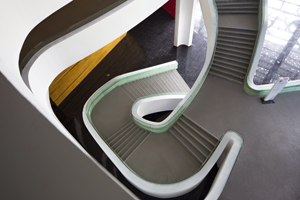 For Gabor Zoboki, another important step was that he was able to convince the officials of Shenzhen, that it is much more important to build a theatre for children than to build cinemas in the smaller hall of the Cultural Centre: “In a city, where there are 5 million children, it is an undeniable need to have a theatre, where they have an opportunity to watch puppet productions or smaller music productions, participating in different artistic workshops.” For Gabor Zoboki, another important step was that he was able to convince the officials of Shenzhen, that it is much more important to build a theatre for children than to build cinemas in the smaller hall of the Cultural Centre: “In a city, where there are 5 million children, it is an undeniable need to have a theatre, where they have an opportunity to watch puppet productions or smaller music productions, participating in different artistic workshops.”
All levels of the Cultural Centre are connected by a large scale foyer where the space greets visitors with large blue and red walls, images of the of Chinese theatre masks. The different levels are linked with white ribbon-like walkways. The overall architectural vision of the entire building complex is characterized by the metal floating roof which hovers above the entire complex, fabricated from tens of thousands of individually made aluminium forms.
Another goal and challenge for the architects was to create a building, which is sustainable and environment-friendly, as in traditional Chinese construction these issues do not always receive adequate emphasis. An important component of the issue of sustainability is the use of sun collectors and realising that the huge amount of energy necessary to manage the climate control of such a building can be decreased substantially.
Gabor Zoboki summarized the key message of their work in Shenzhen as follows: “For many architects building in China is an opportunity to create larger than life creations. These buildings look amazing, but for us architecture is about understanding the locals and using our experiences in their best interest.” |
|
 |
 |
 |
 |
 |
 |
 |
LOCATION |
 |
|
|
 |
|
 |
 |
 |

|
 |

|
Continent |
|
 |
  Asia |
|
Nation |
|
 |
  China [Zhōngguó/Zhōnghuá] |
|
Province |
|
 |
  Guangdong |
|
Town |
|
 |
  Shenzhen |
|
District |
|
 |
  Nanshan |
|
Address |
|
 |
  Changxing Road (Hongua Road, Nanshan Avenue)
|
|
|
|
 |
|
 |
 |
 |
 |
MAP |
 |
|
|
 |
|
 |
 |
 |
| |
 |
|
 |
 |
 |
 |
|
TYPOLOGY |
 |
|
|
 |
|
 |
 |
 |
|
|
 |
ARCHITECTURE | Buildings for cultural activities
Cultural centres and community centres
Buildings for recreational activities
Auditoriums and music centres
Theatres
Children's spaces
| |
 |
 |
 |
 |
CHRONOLOGY |
 |
|
|
 |
|
 |
 |
 |
Project |
 |
|
 |
| 
 |
2008
|
|
Realisation |
 |
|
 |
| 
 |
2014 |
|
 |
 |
 |
 |
CLIENT |
 |
|
|
 |
|
 |
 |
 |
| |
 |
| Nanshan Bureau for Projects, Shenzhen |
|
 |
 |
 |
 |
DIMENSIONAL
DATA |
 |
|
|
 |
|
 |
 |
 |
| Capacity |
 |
|
 |
concert hall 1.400 seats
children's theatre 350 seats |
|
 |
 |
 |
 |
STRUCTURES |
 |
|
|
 |
|
 |
 |
 |
| |
 |
Gábor Földvári (Földvári Architect Office)
András Szabó (System Steel Ltd.) |
|
 |
 |
 |
 |
LANDSCAPE DESIGN |
 |
|
|
 |
|
 |
 |
 |
| |
 |
|
 |
 |
 |
 |
STAFF |
 |
|
|
 |
|
 |
 |
 |
|
 |
|
Design architects |
 |
| Gábor Zoboki, Nóra Demeter |
|
Project architect |
 |
| Csaba Silvester, Zoltán Turi, István Országh |
|
Design team |
 |
| Gábor Szatmári, László Rózsás, János Erőss, Péter Böhler, Nóra Hess, Endre Finta, Csaba Rajnai, Richárd Borzák, László Kakas, Linda Tolnai, Miklós Leits, Béla Reppert, Adrián Savanyú, Krisztián Jancsó, Béla Szokolay, Erik Halmosi, Eszter Kovács |
|
Theatre consultant |
 |
| Lőrinc Strack, Zsuzsa Tompai |
|
Acoustical consultant |
 |
| Federico Cruz Barney, Studio DAP, Paris |
|
Mechanical engineer |
 |
Zsolt Kálmán (Kálmán and Partners Mechanical Engineering)
János Bukovics (G&B Plan Ltd.) |
|
Electrical engineer |
 |
| Ferenc Rajkai (Hungaroproject Engineering Office) |
|
Project management |
 |
|
Architect of record |
 |
Zhang Zhenzhou, Ding Wei, Chen Linshang (CCDI)
Bao Ying Dan, Mei Xiang Yang (SEDI)
X Urban |
|
 |
 |
 |
 |
CREDITS |
 |
|
|
 |
|
 |
 |
 |
| |
 |
Photos © Tiani Wei, Zang Chao
Drawings © Zoboki-Demeter & Associates Architects
Text edited by Zoboki-Demeter & Associates Architects | Zerocom
Courtesy of Zerocom
|
|
 |
  |
 |
|
|